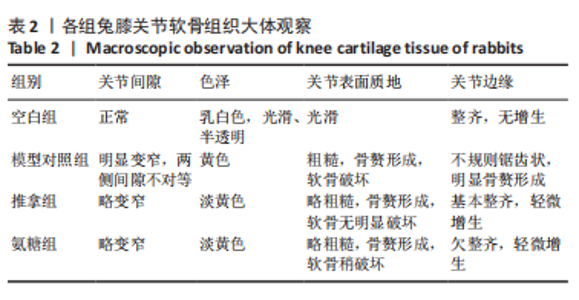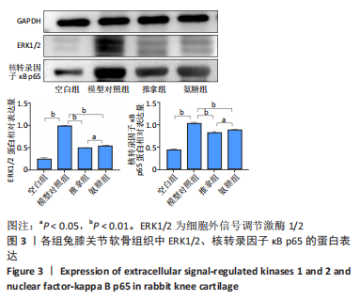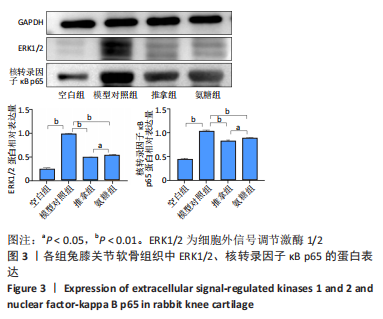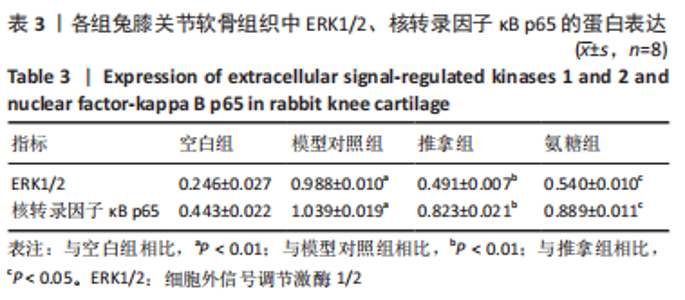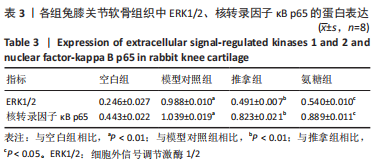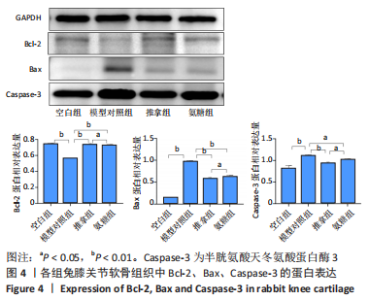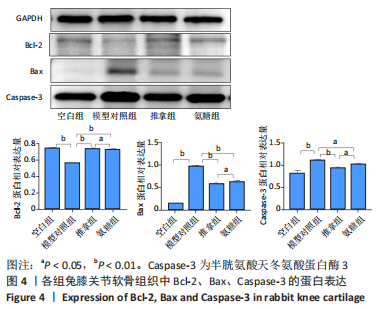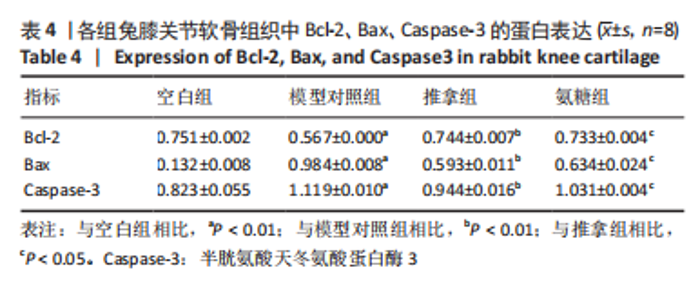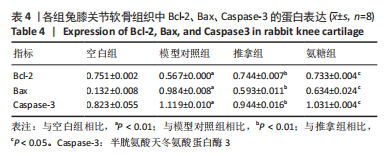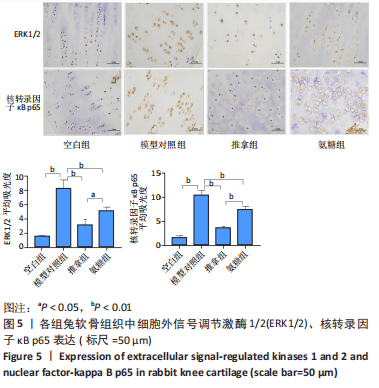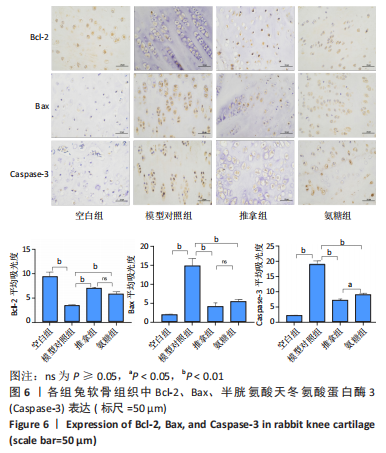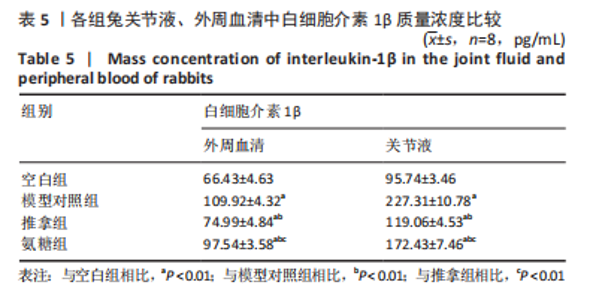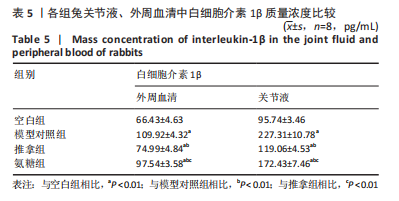Chinese Journal of Tissue Engineering Research ›› 2023, Vol. 27 ›› Issue (35): 5681-5687.doi: 10.12307/2023.819
Previous Articles Next Articles
Shutiao Jingjin Massage can stabilize intracellular environment of rabbit chondrocytes following knee osteoarthritis-induced cartilage injury
Zheng Lijun1, Wang Kai1, Li Muzhen1, Wang Jianmin2, Qiao Yingjie1, Li Huadong2
- 1Shandong University of Traditional Chinese Medicine, Jinan 250014, Shandong Province, China; 2Department of Massage, Affiliated Hospital of Shandong University of Traditional Chinese Medicine, Jinan 250014, Shandong Province, China
-
Received:2022-08-30Accepted:2022-10-31Online:2023-12-18Published:2023-06-05 -
Contact:Li Huadong, MD, Chief physician, Professor, Department of Massage, Affiliated Hospital of Shandong University of Traditional Chinese Medicine, Jinan 250014, Shandong Province, China -
About author:Zheng Lijun, MD candidate, Shandong University of Traditional Chinese Medicine, Jinan 250014, Shandong Province, China -
Supported by:Shandong Provincial Science and Technology Project of Traditional Chinese Medicine, No. 2021Q080 (to LMZ); Qilu Traditional Chinese Medicine Academic School Inheritance Project, No. [2022]93 (to LHD)
CLC Number:
Cite this article
Zheng Lijun, Wang Kai, Li Muzhen, Wang Jianmin, Qiao Yingjie, Li Huadong. Shutiao Jingjin Massage can stabilize intracellular environment of rabbit chondrocytes following knee osteoarthritis-induced cartilage injury[J]. Chinese Journal of Tissue Engineering Research, 2023, 27(35): 5681-5687.
share this article
Add to citation manager EndNote|Reference Manager|ProCite|BibTeX|RefWorks

2.4 各组兔软骨组织病理染色情况 空白组:软骨表层光滑无异常缺损、破坏,软骨细胞均匀密集排列,呈梭形,软骨与软骨下骨分界清析,潮线清晰规整(图2A)。 模型对照组:软骨表面可见缺损、破坏,软骨层变薄,软骨细胞异常聚集,多呈簇状分布,潮线破坏、不连续(图2B)。 推拿组:软骨表层基质被红染,颜色较模型对照组鲜艳,胶原纤维层被染成绿色,染色范围介于空白组和模型对照组之间,软骨与软骨下骨分界较清晰,潮线较规整,软骨表面无明显缺损、破坏,软骨细胞排列基本正常,无明显异常聚集(图2C)。 氨糖组:关节软骨表面不完整,部分软骨表层可见缺损、破坏,与空白组比较,软骨基质番红染色范围较小,绿染范围较大,潮线分布不规整,与模型对照组相比未见有明显改善(图2D)。"
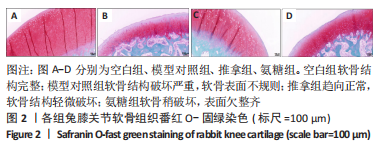
| [1] 黎丹东,李琳琳,苏峰,等.膝骨关节炎与性别和年龄的相关性研究[J].临床医学研究与实践,2019,4(31):1-3+8. [2] 张洪美.膝骨关节炎的规范诊治与阶梯治疗[J].中国骨伤,2019, 32(5):391-395. [3] 中华医学会骨科学分会关节外科学组.骨关节炎诊疗指南(2018年版)[J].中华骨科杂志,2018,38(12):705-715. [4] CHEN P,HUANG L,MA Y, et al. Intra-articular platelet- rich plasma injection for knee osteoarthritis: a summary of meta-analyses. J Orthop Surg Res. 2019;14(1):385-396. [5] D’APUZZO M,WESTRICH G,HIDAKA C, et al. All-cause versus complication-specific readmission following total knee arthroplasty. J Bone Joint Surg Am. 2017;99(13):1093-1103. [6] BANNURU RR, OSANI MC, VAYSBROT EE, et al. OARSI guidelines for the non-surgical management of knee,hip,andpolyarticular osteoarthritis. Osteoarthr Cartil. 2019;27(11):1578. [7] 陈卫衡.膝骨关节炎中医诊疗指南(2020年版)[J].中医正骨,2020, 32(10):1-14. [8] 王锴,董雪,林剑浩.影响膝关节骨关节炎患者生活质量预后因素的队列研究[J].中华骨科杂志,2019,39(18):1149-1156. [9] 廖建钊,章晓云,张璇,等.骨性关节炎发生发展中的分子信号通路[J].中国组织工程研究,2020,24(21):3394-3400. [10] ZHANG FJ, YU WB, LUO W, et al. Effect of osteopontin on TIMP-1 and TIMP-2 mRNA in chondrocytes of human knee osteoarthritis in vitro. Exp Ther Med. 2014;8(2):391-394. [11] 杨永菊,张师侥,关雪峰.膝骨关节炎治疗最新进展[J].世界中西医结合杂志,2018,13(4):589-592. [12] 吴佳航. 基于“筋为骨用”理论研究“舒筋”手法促进膝关节骨性关节炎软骨修复的作用机制[D].成都:成都中医药大学,2018. [13] 周洲,吴宪宗.对推拿镇痛作用的生理机制初探[J].按摩与导引, 1993(2):13-15. [14] MURTON AJ, GREENHAFF PL. Resistance exercise and the mechanisms of muscle mass regulation in humans: acute effects on muscle protein turnover and the gaps in our understanding of chronic resistance exercise training adaptation. Int J Biochem Cell Biol. 2013;6:5-17. [15] BOTERO JP, SHIGUEMOTO GE, PRESTES J, et al. Effects of long-term periodized resistance training on body composition, leptin, resistin and muscle strength in elderly post-menopausal women. J Sports Med Phys Fitness. 2013;53(3):289-294. [16] KARDOS D, MARSCHALL B, SIMON M, et al. Investigation of Cytokine Changes in Osteoarthritic Knee Joint Tissues in Response to Hyperacute Serum Treatment. Cells. 2019;8(8):824. [17] ARRA M, SWARNKAR G, KE K, et al. LDHA-mediated ROS generation in chondrocytes is a potential therapeutic target for osteoarthritis. Nat Commun. 2020;11(1):3427. [18] WANG D, WANG Z, LI M, et al. The underlying mechanism of partial anterior cruciate ligament injuries to the meniscus degeneration of knee joint in rabbit models. J Orthop Surg Res. 2020;15(1):428. [19] LAN CN, CAI WJ, SHI J, et al. MAPK inhibitors protect against earlystage osteoarthritis by activating autophagy. Mol Med Rep. 2021;24(6):829. [20] CHEN YY, YAN XJ, JIANG XH, et al. Vicenin 3 ameliorates ECM degradation by regulating the MAPK pathway in SW1353 chondrocytes. Exp Ther Med. 2021;22(6):1461. [21] CHOW YY, CHIN KY. The role of inflammation in the pathogenesis of osteoarthritis. Mediators Inflamm. 2020;2020:8293921. [22] 高世超,殷海波,刘宏潇,等.MAPK信号通路在骨关节炎发病机制中的研究进展[J].中国骨伤,2014,27(5):441-444. [23] MA N, TENG X, ZHENG Q, et al. The regulatory mechanism of p38/MAPK in the chondrogenic differentiation from bone marrow mesenchymal stem cells. J Orthop Surg Res. 2019;14(1):434. [24] RIGOGLOU S, PAPAVASSILIOU AG. The NF-kB signalling pathway in osteoarthritis. Int J Biochem Cell Biol . 2013;45(11):2580-2584. [25] SCOTECE M,CONDE J,ABELLA V, et al. Oleocanthal inhib- its catabolic and inflammatory mediators in LPS-activated human primary osteoarthritis(OA) chondrocytes through MAPKs/NF-kappaB pathways. Cell Physiol Biochem. 2018;49(6):2414-2426. [26] ZHONG JH, LI J, LIU CF, et al. Effects of microRNA-146a on the proliferation and apoptosis of human osteoarthritis chondrocytes by targeting TRAF6 through the NF-κB signalling pathway. Biosc Rep. 2017;37(2):1-10. [27] MARCY KB, OTERO M, OLIVOTTO E, et al. NF-kappaB signaling: multiple angles to target OA. Curr Drug Targets. 2010;11(5):599-613. [28] YAN HQ, ZHANG D, SHI YY, et al. Ataxia-telangiectasia mutated activation mediates tumor necrosis factor-alpha induced MMP-13 up-regulation and metastasis in lung cancer cells. Oncotarget. 2016;7(38): 62070-62083. [29] 李红波,苏磊,林新峰,等.HSP27在热打击致F98细胞氧化应激损伤及细胞凋亡中的作用[J].解放军医学杂志,2018,43(10):854-859. [30] SUN ZY, YIN ZM, LIU C, et al. IL-1β promotes ADAMTS enzyme-mediated aggrecan degradation through NF-κB in human intervertebral disc. J Orthop Surg Res. 2015;10(1):159. [31] TU J, LI WT, ZHANG YK, et al. Simvastatin in hibits IL-1β-induced apoptosis and extracellular matrix degradation by suppressing the NF-kB and MAPK path- ways in nucleus pulposus cells. Inflammation. 2017;40(3):725-734. [32] LIU F, LI L, LU W, et al. Scutellarin ameliorates cartilage degeneration in osteoarthritis by inhibiting the Wnt/β-catenin and MAPK signaling pathways. Int Immunopharmacol. 2020;78:105954. [33] WALENSKY LD. Targeting BAX to drug death directly. Nat Chem Biol. 2019;15(7):657-665. |
| [1] | Li Yongjie, Fu Shenyu, Xia Yuan, Zhang Dakuan, Liu Hongju. Correlation of knee extensor muscle strength and spatiotemporal gait parameters with peak knee flexion/adduction moment in female patients with knee osteoarthritis [J]. Chinese Journal of Tissue Engineering Research, 2024, 28(9): 1354-1358. |
| [2] | Du Changling, Shi Hui, Zhang Shoutao, Meng Tao, Liu Dong, Li Jian, Cao Heng, Xu Chuang. Efficacy and safety of different applications of tranexamic acid in high tibial osteotomy [J]. Chinese Journal of Tissue Engineering Research, 2024, 28(9): 1409-1413. |
| [3] | Huang Xiarong, Hu Lizhi, Sun Guanghua, Peng Xinke, Liao Ying, Liao Yuan, Liu Jing, Yin Linwei, Zhong Peirui, Peng Ting, Zhou Jun, Qu Mengjian. Effect of electroacupuncture on the expression of P53 and P21 in articular cartilage and subchondral bone of aged rats with knee osteoarthritis [J]. Chinese Journal of Tissue Engineering Research, 2024, 28(8): 1174-1179. |
| [4] | Zhang Zeyi, Yang Yimin, Li Wenyan, Zhang Meizhen. Effect of foot progression angle on lower extremity kinetics of knee osteoarthritis patients of different ages: a systematic review and meta-analysis [J]. Chinese Journal of Tissue Engineering Research, 2024, 28(6): 968-975. |
| [5] | Shen Feiyan, Yao Jixiang, Su Shanshan, Zhao Zhongmin, Tang Weidong. Knockdown of circRNA WD repeat containing protein 1 inhibits proliferation and induces apoptosis of chondrocytes in knee osteoarthritis [J]. Chinese Journal of Tissue Engineering Research, 2024, 28(4): 499-504. |
| [6] | Li Chun, Zhang Yanlin, Liu Di, Wang Minglei, Wang Duo, Liu Junwei, Wu Yongli. Effect of warm-needling moxibustion on anterior cruciate ligament injury repair and related growth factors in rabbits with knee osteoarthritis [J]. Chinese Journal of Tissue Engineering Research, 2024, 28(23): 3621-3626. |
| [7] | Yang Yongze, Cheng Qinghao, Zhang Anren, Yang Xin, Zhang Zhuangzhuang, Fan Hua, Zhang Fukang, Guo Hongzhang. Advantages and disadvantages of trauma effects during robot-assisted total knee arthroplasty [J]. Chinese Journal of Tissue Engineering Research, 2024, 28(21): 3413-3417. |
| [8] | Zhang Kai, Zhao Mingxin, Yang Yuzhu, Guo Yuan, Ji Binping. Effect of tibial prosthesis riser length on knee biomechanics after unicompartmental knee arthroplasty [J]. Chinese Journal of Tissue Engineering Research, 2024, 28(21): 3281-3285. |
| [9] | Yin Yuetong, Zhu Guangyu, Tian Xiangdong, Tan Yetong, Ma Sheng, Xue Zhipeng, Hu Yuanyi, Li Xiaomin. Effects of distal tibial tuberosity-high tibial osteotomy on ankle angle on coronal plane [J]. Chinese Journal of Tissue Engineering Research, 2024, 28(21): 3349-3354. |
| [10] | Zhu Shijie, Yang Yiting, Cao Yuting, Zheng Liangdong, Lin Kaili, Zhu Rui. Cartilage protective effect of swimming exercise in aged mice with knee osteoarthritis [J]. Chinese Journal of Tissue Engineering Research, 2024, 28(20): 3170-3175. |
| [11] | Wang Ke, Zhang Zeyi, Zhang Liwen, Zhang Meizhen. Biomechanics characteristics during sitting up in knee osteoarthritis patients of different ages: a systematic review and meta-analysis [J]. Chinese Journal of Tissue Engineering Research, 2024, 28(18): 2939-2946. |
| [12] | Gu Xu, Zheng Xin, Shi Sifeng, Lu Renxiang, Cao Jie, Li Hongwei. Stability of early gait after unicompartmental knee arthroplasty [J]. Chinese Journal of Tissue Engineering Research, 2024, 28(12): 1875-1879. |
| [13] | Zhang Huizhen, Wu Wei, Luo Haitao. Medium to low intensity exercise interferes with the expression of LncRNA HOTAIR in chondrocytes in high-fat-fed mice with knee joint damage [J]. Chinese Journal of Tissue Engineering Research, 2024, 28(11): 1684-1689. |
| [14] | Zeng Jiaxu, He Qi, Chen Bohao, Li Miao, Li Shaocong, Yang Junzheng, Pan Zhaofeng, Wang Haibin. An insight into the mechanism of iron overload in knee osteoarthritis under the theory of blood stasis [J]. Chinese Journal of Tissue Engineering Research, 2024, 28(11): 1743-1748. |
| [15] | Mo Jian, Ye Sentao, Zhang Xiaoyun. Progress in the treatment of knee osteoarthritis with monomer and compound Chinese medicine [J]. Chinese Journal of Tissue Engineering Research, 2024, 28(11): 1756-1761. |
| Viewed | ||||||
|
Full text |
|
|||||
|
Abstract |
|
|||||


